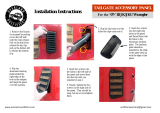
10 BE-RTH120 USER MANUAL
REF PART NUM DESCRIPTION QTY
1 “R” Clip - 4mm 3
2 T10-66-01-02-02 Hitch Pin (Lower Hitch Block) 2
3 TX.02-02 Lower Hitch Bracket 2
4 TX.02-03 “U” Bolt, Lower Hitch Bracket 2
5 GB/T6177.1 Hex Nut - U-Bolt (Lower Hitch Brckt.) 4
6 GB5783 Bolt - 10x1.5x30 24
7 TX.01.01 A-Frame 1
8A TX.03.04-02 Support - Gearbox Shielding 1
8B TX.03.04-01 Gearbox Shield 1
9 GB5783 Bolt - 8x1.25x16 7
10 T10-66-01-03-01 Top Hitch Pin 1
12 HG4-692-67 Oil Seal 35-62-10 1
13 GB/T893.1-1986 Snap Ring - Inner 62mm 1
14 GB/T 279 Bearing 6007 1
15 TX03-07 Input Shaft 1
16 GB/T 894.2 Snap Ring Ext. 30mm 1
17 TX03-03 Pinion Gear 1
18 GB/T 297 Bearing 30305 (same as #556) 1
19 GB/T 893.1 Snap Ring - Inner 62mm 1
20 Gearbox Cap 1
21 GB/T 894.2 Snap Ring Ext. 34mm 3
22 TX.04-02 Shim 4
23 TXC.05-07 Top Gear / Sprocket 1
25 GB/T 307 Bearing 6207-2RS 2
26 TX03-04
Drive Shaft TXG32 1
Drive Shaft TXG40 1
Drive Shaft TXG48 1
Drive Shaft TXG56 1
27 TX.03-06 Gasket - Drive Shaft 1
28 TX.03.01
Drive Shaft Tube Housing TXG32 1
Drive Shaft Tube Housing TXG40 1
Drive Shaft Tube Housing TXG48 1
Drive Shaft Tube Housing TXG56 1
29 GB5783 Bolt 10x1.5x25 8
31 TX.03-04 Ring Gear 1
35 TX.03-02 Housing - Gearbox 1
36 Gearbox Oil Plug (Dip Stick) 1
37 Oil Plug 1
38 TX.03-01 Lifting Hook 1
39 GB5783 Bolt M12x12 2
41 Breather Cap 1
42 GB5783 Bolt 10x1.5x25 2
43 T10-66-05-01 Stand Bracket 1
44 R-Clip - 3mm 1
45 T10-66-05-01 Pin - Stand 1
47 T10-66-05-01 Stand Leg 1
REF PART NUM DESCRIPTION QTY
48 TX.06.01 Skid Weldment - Left
49 Nylon Lock Nut M24*1.5
50 O-Ring - Idler Gear Support Shaft 1
51 TX.05.01 Side Drive Cover 1
52 Oil Plug 1
53 TX.05-01 Gasket - Side Gear/Chain Case 1
54 GB5783 Bolt - 8x1.25x20 13
56 GB/T297-1994 Bearing 30305 2
57 GB/T893.1 Snap Ring - Inner 62mm 1
58 TXC.05-11 Spacer 1
59 TXC.05-08 Idler Gear 1
60 GB/T 812 Nut - Rotor 1
61 GB/T 858 Star Washer - Rotor 1
62 TXC.05-09 Bottom Gear/Sprocket 1
63 TX.03.02 Side Panel - Left 1
65 GB/T276-1994 Bearing 6207 2
66 TX.04-06 Gasket - Rotor 2
67 GB5783 Bolt - 10x1.5x25 4
68 TX.04-03 Bearing Support - Left Side 1
70 HG4-692-67 Oil Seal - 40x62x10 2
71 TX.04-04 Blade - Left -
Blade - Right -
72 TX.04.01
Rotor - TXG32 1
Rotor - TXG40 1
Rotor - TXG48 1
Rotor - TXG56 1
73 GB/T5786-86
Bolt - 12x1.25x35 -
Nut - 12mm Fine Thread -
Lock Washer - 12mm -
76 TX.04-03 Bearing Support 1
81 TX.02-01 Side Panel - Right 1
82 GB5783 Bolt 10x1.5x25 3
83 JB/T 7940.1 Grease Fitting 1
84 TX.06.02 Skid Weldment - Right 1
87 TX.02
Frame Weldment - TXG-32 1
Frame Weldment - TXG-40 1
Frame Weldment - TXG-48 1
Frame Weldment - TXG-56 1
88 GB5783 Bolt - 16x90 2
Nut - M16 -
89 TX.07
Tailgate TXG-32 1
Tailgate TXG-40 1
Tailgate TXG-48 1
Tailgate TXG-56 1
90 Tailgate Chain Assembly 1












